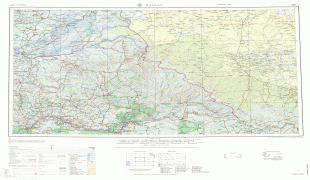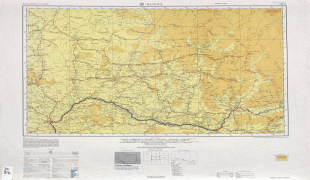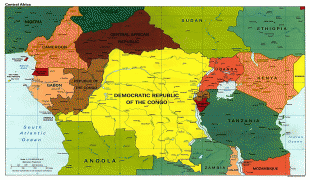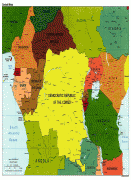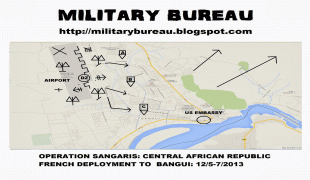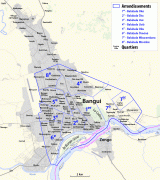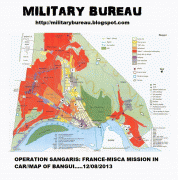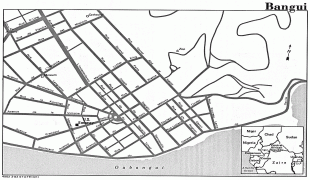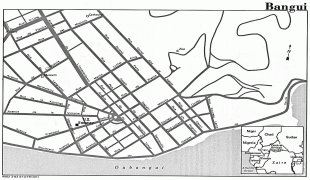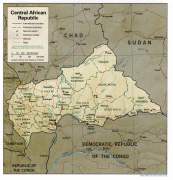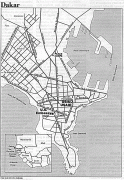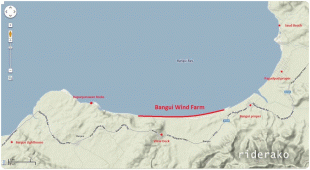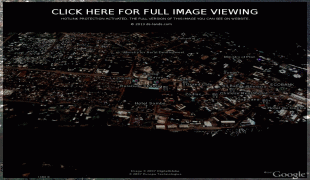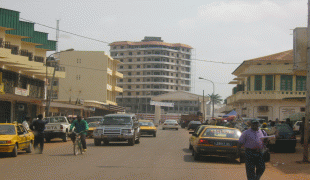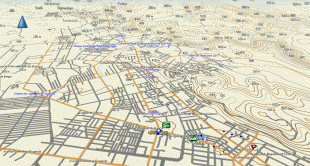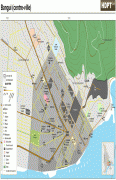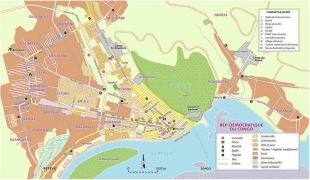Bangui
Bangui (or Bangî in Sango, formerly written Bangi in English) is the capital and largest city of the Central African Republic. It was established as a French outpost in 1889 and named after its location on the northern bank of the Ubangi River (Oubangui); the Ubangi itself was named from the Bobangi word for the "rapids" located beside the settlement, which marked the end of navigable water north from Brazzaville. The majority of the population of the Central African Republic lives in the western parts of the country, in Bangui and the surrounding area.
The city forms an autonomous commune (commune autonome) of the Central African Republic which is surrounded by the Ombella-M'Poko prefecture. With an area of 67 km2, the commune is the smallest high-level administrative division in the country, but the highest in terms of population. it had an estimated population of 889,231.
The city consists of eight urban districts (arrondissements), 16 groups (groupements) and 205 neighbourhoods (quartiers). As the capital of the Central African Republic, Bangui acts as an administrative, trade, and commercial centre. The National Assembly, government buildings, banks, foreign enterprises and embassies, hospitals, hotels, main markets and the Ngaragba Central Prison are all located here. Bangui manufactures textiles, food products, beer, shoes and soap. Its Notre-Dame Cathedral is the seat of the Roman Catholic Archdiocese of Bangui. The city is also home to the University of Bangui, inaugurated in 1970. It is also served by the Bangui M'Poko International Airport.
Archaeological studies in and around Bangui have yielded at least 26 ancient Iron Age sites that contain many metallurgical tools and objects, illuminating the pre-European history of the city and surrounding area. The archaeological sites were added to the UNESCO World Heritage Tentative List on 11 April 2006 in the Cultural category. The site closest to Bangui is Pendere-Sengue, 800 m from Independence Avenue, where archaeologists and conservation agencies have carried out studies. It is a paleo-metallurgical site where several thousand shards of ceramics, iron tools, pottery, and an iron spatula weighing 9 kg have been unearthed. Its dating, compared with similar sites in Nigeria and Sudan, could be close to the ninth century BC.
The modern settlement of Bangui was founded by Michel Dolisie and Alfred Uzac on 26 June 1889 on the direction of Brazzaville administrator Albert Dolisie. It was located in what was then the upper reaches of the French Congo, the present-day Congo. The original site was 6 mi south of the Ubangi rapids. Its territory was organized first into the territory of the Upper Ubangi (Haut-Oubangui) and then as the separate colony of Ubangi-Shari. The initial capitals of these areas were at les Abiras and Fort de Possel further upstream, but the rapids at Bangui blocked them from direct communication along the river and caused the settlement there to grow in importance until, in 1906, it was chosen as the new headquarters for the French administration. Bangui retained its importance as a military and administrative centre when the colony was folded into French Equatorial Africa and under both Vichy and Free French control during World War II. The French operated a radio transmitter in Bangui, which was described in 1932 as "the most remote radio station in Africa".
The colony of Ubangi-Shari received its autonomy in 1958 as the Central African Republic and this became independent from France in 1960. In 1970, President Jean-Bédel Bokassa inaugurated the University of Bangui. He established the national airline Air Centrafrique the following year and ordered the construction of two new luxury hotels in Bangui. With tensions mounting between Bangui and Paris as a result of Bokassa's uncontrollable expenditures, western banks refused to lend him any more money. Relations with the French worsened still further in April 1974, when Brigette Miroux's body was discovered in a hotel room in Bangui. It was reported in the French media that she had been Bokassa's mistress and that he was responsible for her murder. As a result, Bokassa banned imports of French newspapers and assumed control of the Agence France-Presse office in Bangui. By 1975, Bangui had a population of 300,723.
In March 1981, widespread violence took place in Bangui following elections, after Operation Caban led the French to drop Bokassa (who had begun to call himself Emperor Bokassa I), and replaced him with David Dacko. Opponents of the President met in Bangui and were forced to flee the country. After returning voluntarily to Bangui in the autumn of 1986, Bokassa went on trial. Initially faced with the death penalty, in February 1988 he was instead sentenced to life imprisonment. His successor was General André Kolingba, army chief of staff of Dacko's army, who took over control from the local French military on 1 September 1981 under the pretext that the country was heading towards civil war. Although he attempted to combat corruption and control the national economy, he was unable to achieve his reforms. By the middle of the 1980s the country's economic situation had deteriorated as 80% of the revenue went towards meeting the salaries of the staff. Under pressure from a donor group called GIBAFOR (France, USA, Japan, Germany, EU, World Bank and the UN) Kolingba made moves to restore a degree of democracy in the country in 1991 with a multiparty government. Elections were held in 1993 and 1994. The first round was sabotaged by the government when it was clear they would lose. Under continued donor pressure elections were held again in 1994 as before with help from the UN electoral Assistance Unit. During these elections, Ange-Félix Patassé was elected to the post of president. Since he was from northern CAR, the southern group of Kolingba started a rebellion during 1996.
In May 1996, about 200 soldiers of the Central African Republic mutinied in Bangui, demanding salary increases and the abdication of Ange-Félix Patassé. In the aftermath, the renegades plundered and killed more than 50 people. Following this, the French troops stationed in the country suppressed the rebellion and restored the dictatorial power. After being elected, President Patassé announced a national unity government in early 1997. The Patassé government, the opposition parties, and religious groups signed the Bangui Agreements in January 1997 which were a series of measures designed to reconcile competing political factions, reform and strengthen the economy. The same year, the rebel troops refused a military base in Bangui and in June a new revolt broke out.
In view of frequent political unrest the city was named in 1996 as one of the most dangerous cities in the world. On 25 October 2002, several towns in the country and later Bangui itself were attacked by the forces of General François Bozizé, backed with international support. Bozizé refused to accept an arrest warrant and "defected with about a hundred troops, engaged in street battles in the northern neighborhoods of Bangui (traditionally supporting Patassé)" and went north. Bozizé went into exile in Chad but his troops returned to Bangui and fighting continued. Peace-keeping forces were ineffective, leaving Patassé isolated, and with support from Chad, Bozizé's troops were successful in removing Patassé's government. Patassé, who was returning from Niger after attending a conference, was not permitted to land in Bangui and he took asylum in Togo, and Bozizé seized power and suspended the constitution. An all-party National Transitional Government was set up which functioned as an interim legislative body. However, the "climate of distrust continued".
The city forms an autonomous commune (commune autonome) of the Central African Republic which is surrounded by the Ombella-M'Poko prefecture. With an area of 67 km2, the commune is the smallest high-level administrative division in the country, but the highest in terms of population. it had an estimated population of 889,231.
The city consists of eight urban districts (arrondissements), 16 groups (groupements) and 205 neighbourhoods (quartiers). As the capital of the Central African Republic, Bangui acts as an administrative, trade, and commercial centre. The National Assembly, government buildings, banks, foreign enterprises and embassies, hospitals, hotels, main markets and the Ngaragba Central Prison are all located here. Bangui manufactures textiles, food products, beer, shoes and soap. Its Notre-Dame Cathedral is the seat of the Roman Catholic Archdiocese of Bangui. The city is also home to the University of Bangui, inaugurated in 1970. It is also served by the Bangui M'Poko International Airport.
Archaeological studies in and around Bangui have yielded at least 26 ancient Iron Age sites that contain many metallurgical tools and objects, illuminating the pre-European history of the city and surrounding area. The archaeological sites were added to the UNESCO World Heritage Tentative List on 11 April 2006 in the Cultural category. The site closest to Bangui is Pendere-Sengue, 800 m from Independence Avenue, where archaeologists and conservation agencies have carried out studies. It is a paleo-metallurgical site where several thousand shards of ceramics, iron tools, pottery, and an iron spatula weighing 9 kg have been unearthed. Its dating, compared with similar sites in Nigeria and Sudan, could be close to the ninth century BC.
The modern settlement of Bangui was founded by Michel Dolisie and Alfred Uzac on 26 June 1889 on the direction of Brazzaville administrator Albert Dolisie. It was located in what was then the upper reaches of the French Congo, the present-day Congo. The original site was 6 mi south of the Ubangi rapids. Its territory was organized first into the territory of the Upper Ubangi (Haut-Oubangui) and then as the separate colony of Ubangi-Shari. The initial capitals of these areas were at les Abiras and Fort de Possel further upstream, but the rapids at Bangui blocked them from direct communication along the river and caused the settlement there to grow in importance until, in 1906, it was chosen as the new headquarters for the French administration. Bangui retained its importance as a military and administrative centre when the colony was folded into French Equatorial Africa and under both Vichy and Free French control during World War II. The French operated a radio transmitter in Bangui, which was described in 1932 as "the most remote radio station in Africa".
The colony of Ubangi-Shari received its autonomy in 1958 as the Central African Republic and this became independent from France in 1960. In 1970, President Jean-Bédel Bokassa inaugurated the University of Bangui. He established the national airline Air Centrafrique the following year and ordered the construction of two new luxury hotels in Bangui. With tensions mounting between Bangui and Paris as a result of Bokassa's uncontrollable expenditures, western banks refused to lend him any more money. Relations with the French worsened still further in April 1974, when Brigette Miroux's body was discovered in a hotel room in Bangui. It was reported in the French media that she had been Bokassa's mistress and that he was responsible for her murder. As a result, Bokassa banned imports of French newspapers and assumed control of the Agence France-Presse office in Bangui. By 1975, Bangui had a population of 300,723.
In March 1981, widespread violence took place in Bangui following elections, after Operation Caban led the French to drop Bokassa (who had begun to call himself Emperor Bokassa I), and replaced him with David Dacko. Opponents of the President met in Bangui and were forced to flee the country. After returning voluntarily to Bangui in the autumn of 1986, Bokassa went on trial. Initially faced with the death penalty, in February 1988 he was instead sentenced to life imprisonment. His successor was General André Kolingba, army chief of staff of Dacko's army, who took over control from the local French military on 1 September 1981 under the pretext that the country was heading towards civil war. Although he attempted to combat corruption and control the national economy, he was unable to achieve his reforms. By the middle of the 1980s the country's economic situation had deteriorated as 80% of the revenue went towards meeting the salaries of the staff. Under pressure from a donor group called GIBAFOR (France, USA, Japan, Germany, EU, World Bank and the UN) Kolingba made moves to restore a degree of democracy in the country in 1991 with a multiparty government. Elections were held in 1993 and 1994. The first round was sabotaged by the government when it was clear they would lose. Under continued donor pressure elections were held again in 1994 as before with help from the UN electoral Assistance Unit. During these elections, Ange-Félix Patassé was elected to the post of president. Since he was from northern CAR, the southern group of Kolingba started a rebellion during 1996.
In May 1996, about 200 soldiers of the Central African Republic mutinied in Bangui, demanding salary increases and the abdication of Ange-Félix Patassé. In the aftermath, the renegades plundered and killed more than 50 people. Following this, the French troops stationed in the country suppressed the rebellion and restored the dictatorial power. After being elected, President Patassé announced a national unity government in early 1997. The Patassé government, the opposition parties, and religious groups signed the Bangui Agreements in January 1997 which were a series of measures designed to reconcile competing political factions, reform and strengthen the economy. The same year, the rebel troops refused a military base in Bangui and in June a new revolt broke out.
In view of frequent political unrest the city was named in 1996 as one of the most dangerous cities in the world. On 25 October 2002, several towns in the country and later Bangui itself were attacked by the forces of General François Bozizé, backed with international support. Bozizé refused to accept an arrest warrant and "defected with about a hundred troops, engaged in street battles in the northern neighborhoods of Bangui (traditionally supporting Patassé)" and went north. Bozizé went into exile in Chad but his troops returned to Bangui and fighting continued. Peace-keeping forces were ineffective, leaving Patassé isolated, and with support from Chad, Bozizé's troops were successful in removing Patassé's government. Patassé, who was returning from Niger after attending a conference, was not permitted to land in Bangui and he took asylum in Togo, and Bozizé seized power and suspended the constitution. An all-party National Transitional Government was set up which functioned as an interim legislative body. However, the "climate of distrust continued".
Map - Bangui
Map
Country - Central_African_Republic
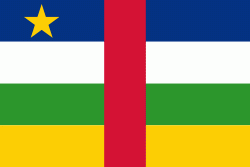 |
 |
| Flag of the Central African Republic | |
The Central African Republic covers a land area of about 620000 km2. , it had an estimated population of around million. , the Central African Republic is the scene of a civil war, which is ongoing since 2012.
Currency / Language
| ISO | Currency | Symbol | Significant figures |
|---|---|---|---|
| XAF | Central African CFA franc | Fr | 0 |
| ISO | Language |
|---|---|
| FR | French language |
| KG | Kongo language |
| LN | Lingala language |
| SG | Sango language |






